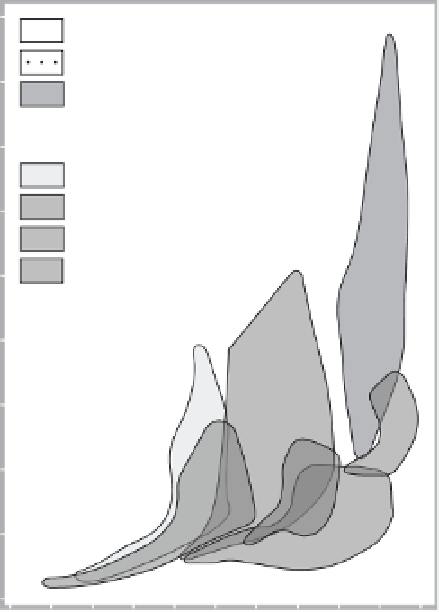Environmental Engineering Reference
In-Depth Information
in N and P, nearly 80% in K, and about 60% in Ca and S
(Nicholaides et al. 1985). In many ecosystems two or
more of these factors operate concurrently or sequen-
tially: low temperatures limit the productivity of boreal
forests in winter, high temperatures, in summer; many
tropical rain forests are co-limited by heavy cloud cover
and poor soils.
3.2 Global Primary Productivity
Primary productivity, the rate of synthesis of new phyto-
mass during a specified period of time (usually a year), is
expressed in three different ways: as assimilated carbon,
as dry matter (DM), or as stored energy. Because of a
large range of moisture contents in fresh (wet) biomass
(from
>
98% in phytoplankton to
<
5% in mature seeds)
it is necessary to use DM values for all comparisons. I
use the carbon metric, and the following conversions
should be used for dry matter and energy: 1 t CA2tof
dry woody phytomass and 2.2 t of dry herbaceous phyto-
mass; 1 t of dry phytomass (average of woody and herba-
ceous species)A17.5 GJ. The rate is quantified on three
levels of diminishing content.
The gross primary productivity (GPP) is the amount of
phytomass (carbon, energy) fixed (after photorespiration
losses) in a year by all photoautotrophs (chemotrophic
prokaryotes that do not energize their biosynthesis
by sunlight are a negligible addition). GPP is reduced by
autotrophic respiration (R
A
) to yield the net primary
productivity (NPP): NPP
¼
GPP
R
A
. NPP is the
most frequently used rate in modern bioenergetic studies
concerned with the photosynthetic performance of eco-
systems. There are two interpretations of NPP: one pos-
its that the rate must be
b
0; the other allows NPP to be
negative during the periods when R
A
>
GPP (Roxburgh
et al. 2005). I use the first convention.
3.4 Average annual temperature, precipitation, and major
biomes. Based on Lieth and Whittaker (1975).
Temperate deciduous ecosystems need at least 0
C and
photosynthesize best at about 25
C; in the tropics both
the minima and maxima are about 10
C higher.
Insolation is the primarily limiting factor of photosyn-
thesis over 27% of the world's vegetated area, particularly
in cloudy tropical lowlands (see section 2.2). Nutrient
shortages limit the productivity of grasslands and woody
phytomass in many arid regions as well as forest growth
in such well-watered and thermally ideal environments
as the Amazon basin, where 90% of soils are deficient
















































